A Guide to the Best Arborvitae Varieties to Plant in Your Garden
Published: November 3, 2025 at 9:47:24 PM UTC
Arborvitae trees have become a staple in many landscapes, offering year-round greenery, privacy, and architectural structure. These versatile evergreens are prized for their low maintenance requirements and ability to thrive in various conditions. Whether you're looking to create a living privacy fence, add a focal point to your landscape, or enhance your garden's structure, there's an Arborvitae variety perfectly suited to your needs.

In this comprehensive guide, we'll explore the most popular and reliable Arborvitae varieties, their unique characteristics, and how to select the perfect option for your specific garden conditions. From the towering 'Green Giant' to the compact 'Emerald Green,' we'll help you navigate the world of these exceptional landscape trees.
Different Arborvitae varieties offer unique shapes, sizes, and colors for various landscape applications
Benefits of Planting Arborvitae in Your Landscape
Before diving into specific varieties, let's explore why Arborvitae has become such a popular choice for gardeners and landscapers across North America:
Privacy & Screening
Many Arborvitae varieties grow in a dense, columnar form that creates effective visual barriers and windbreaks. Their year-round foliage ensures privacy in all seasons, unlike deciduous trees that lose their leaves.
Versatility
From towering specimens reaching 50+ feet to compact globes just a few feet tall, Arborvitae comes in sizes and shapes to suit virtually any landscape need. They work beautifully as hedges, accent plants, or foundation plantings.
Low Maintenance
Once established, most Arborvitae varieties require minimal care. They naturally maintain their attractive shape with little or no pruning and are generally resistant to many common garden pests and diseases.
Environmental Benefits
As evergreens, Arborvitae provide year-round habitat and food for wildlife. Birds particularly appreciate the dense foliage for nesting and shelter, while some species feed on the small cones produced by mature trees.
Adaptability
While they prefer well-drained soil, many Arborvitae varieties can adapt to a range of soil conditions and climate zones. Some varieties are exceptionally cold-hardy, thriving even in challenging northern climates.
Aesthetic Appeal
The soft, scale-like foliage of Arborvitae creates an attractive texture in the landscape. Different varieties offer various shades of green, with some displaying gold or bronze tones, especially in winter.
Top Arborvitae Varieties for Your Garden
With dozens of Arborvitae cultivars available, selecting the right one can feel overwhelming. We've narrowed down the options to the most reliable, attractive, and versatile varieties to simplify your decision.
1. Green Giant Arborvitae (Thuja plicata x standishii)
The 'Green Giant' has earned its reputation as one of America's most distinguished landscape trees. This hybrid variety combines rapid growth with impressive height and disease resistance, making it a top choice for privacy screens and windbreaks.
Advantages
- Exceptional growth rate of 3+ feet per year
- Reaches impressive mature heights of 50-60 feet
- Maintains rich green color year-round with minimal bronzing in winter
- Highly resistant to diseases and pests
- Requires minimal pruning to maintain its natural pyramidal shape
Considerations
- Requires adequate spacing (15-20 feet spread at maturity)
- May be too large for smaller properties
- Not as cold-hardy as some native varieties (USDA zones 5-8)
- Can experience some winter bronzing in colder climates
For creating a privacy screen with 'Green Giant', space plants 5-8 feet apart. In just a few years, they'll grow together to form a seamless living wall. This variety thrives in full sun to partial shade and adapts to various soil types as long as drainage is good.
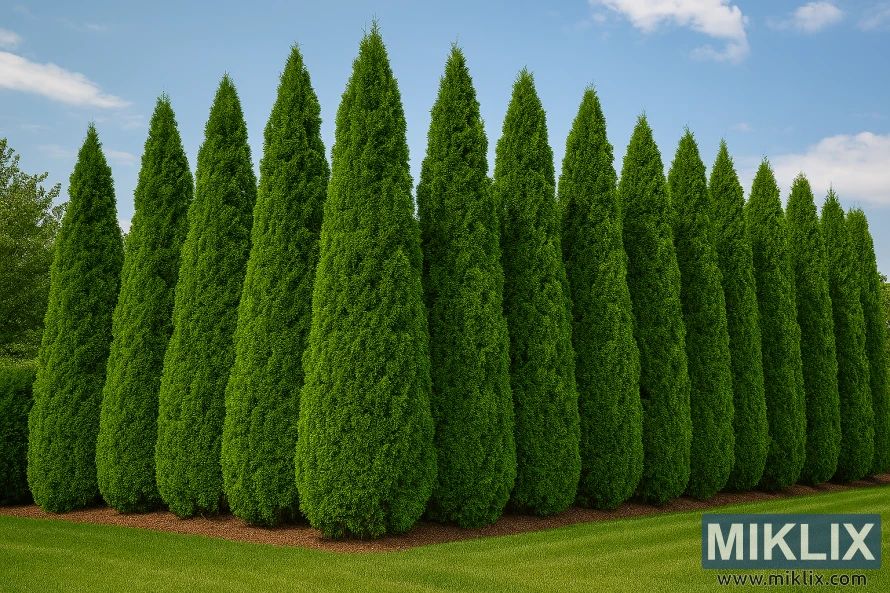
2. Emerald Green Arborvitae (Thuja occidentalis 'Smaragd')
The 'Emerald Green' Arborvitae (also known as 'Smaragd') is a native North American variety that has become extremely popular for smaller gardens and spaces where the larger 'Green Giant' would overwhelm the landscape.
Advantages
- Compact size (12-15 feet tall, 3-4 feet wide at maturity)
- Maintains bright emerald green color year-round
- Moderate growth rate of 12-18 inches per year
- Excellent cold hardiness (USDA zones 2-7)
- Perfect for smaller properties and garden spaces
Considerations
- May require occasional shearing to maintain compact form
- Can experience some winter yellowing in harsh climates
- More susceptible to bagworms than some varieties
- Slower growing than 'Green Giant'
'Emerald Green' is ideal for creating medium-height privacy screens, garden borders, or as accent plants. Plant them 2-3 feet apart for a hedge that will fill in within a few years. This variety performs best in full sun but tolerates partial shade and adapts to most well-drained soils.
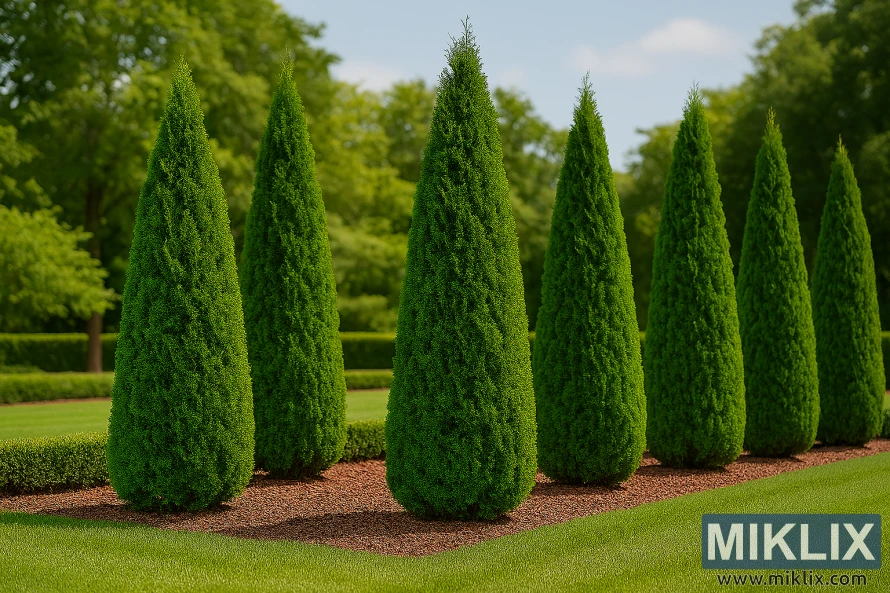
3. Techny Arborvitae (Thuja occidentalis 'Techny')
Also known as 'Mission' Arborvitae, the 'Techny' variety offers a perfect middle ground between the towering 'Green Giant' and the more compact 'Emerald Green'. Its rich, dark green foliage and excellent cold hardiness make it a favorite in northern regions.
Advantages
- Medium size (15-25 feet tall, 6-10 feet wide at maturity)
- Maintains deep green color throughout winter
- Excellent cold hardiness (USDA zones 2-8)
- Dense foliage creates effective privacy screens
- More resistant to winter burn than many varieties
Considerations
- Moderate growth rate (slower than 'Green Giant')
- Wider spread requires more space than 'Emerald Green'
- May need occasional pruning to maintain desired shape
- Can be susceptible to bagworms in some regions
'Techny' Arborvitae is particularly well-suited for privacy screens in colder climates where winter hardiness is essential. Plant them 3-4 feet apart for a hedge that will fill in nicely. This variety adapts to various soil conditions but performs best in moist, well-drained soil.

4. American Arborvitae (Thuja occidentalis)
The American Arborvitae is the native species from which many popular cultivars have been developed. In its natural form, it grows as a medium to large tree with a pyramidal to conical shape. This variety offers significant ecological benefits and is an excellent choice for naturalistic landscapes.
Advantages
- Native to North America (supports local ecosystems)
- Provides valuable wildlife habitat and food
- Excellent cold hardiness (USDA zones 2-7)
- Can reach 40-60 feet tall in optimal conditions
- Adapts to various soil conditions including wet areas
Considerations
- Less uniform shape than cultivated varieties
- May thin out with age at the base
- Moderate growth rate
- Can bronze in winter, especially in exposed sites
The American Arborvitae is ideal for naturalistic landscapes, restoration projects, and areas where wildlife habitat is a priority. It's particularly well-adapted to areas with moist soil and can even tolerate occasional flooding, making it suitable for rain gardens and wetland margins.
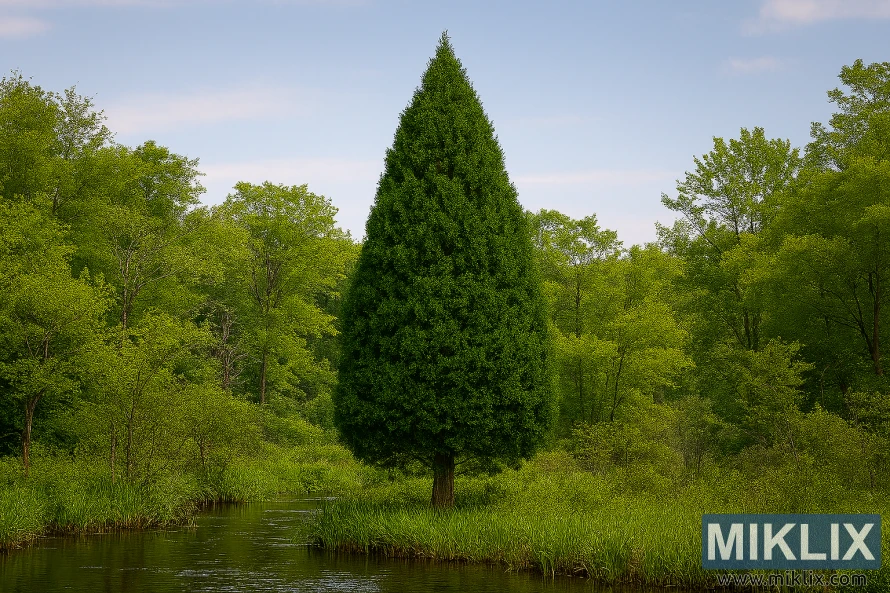
5. North Pole Arborvitae (Thuja occidentalis 'Art Boe')
The 'North Pole' Arborvitae is a relatively recent introduction that combines the cold hardiness of native varieties with an exceptionally narrow, columnar growth habit. This makes it perfect for tight spaces where vertical accent is desired.
Advantages
- Extremely narrow form (10-15 feet tall, just 3-5 feet wide)
- Outstanding cold hardiness (USDA zones 3-7)
- Maintains dark green color throughout winter
- Resistant to winter burn
- Perfect for small spaces and narrow planting areas
Considerations
- Moderate growth rate
- May need staking when young in windy sites
- Not as tall as some varieties for complete privacy
- Relatively new variety with less long-term performance data
'North Pole' Arborvitae is ideal for narrow spaces between buildings, as a vertical accent in foundation plantings, or anywhere space is limited but vertical interest is desired. Plant them 2-3 feet apart for a narrow hedge or screen. This variety performs best in full sun to light shade.
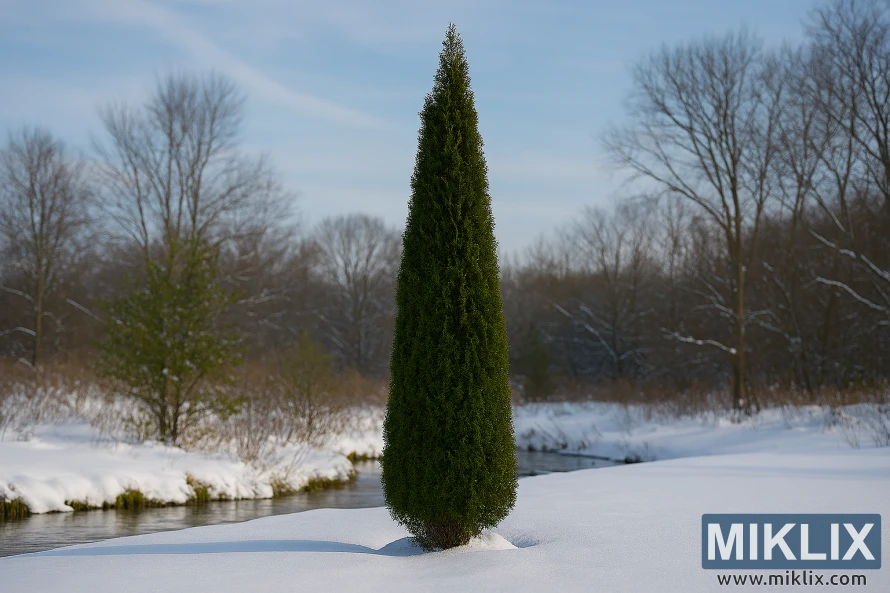
Arborvitae Variety Comparison
To help you select the perfect Arborvitae for your landscape needs, we've created this comprehensive comparison of the top varieties:
| Variety | Mature Height | Mature Width | Growth Rate | USDA Zones | Best Uses |
| Green Giant | 50-60 feet | 15-20 feet | 3+ feet/year | 5-8 | Tall privacy screens, windbreaks |
| Emerald Green | 12-15 feet | 3-4 feet | 1-1.5 feet/year | 2-7 | Medium hedges, foundation plantings |
| Techny | 15-25 feet | 6-10 feet | 1-2 feet/year | 2-8 | Privacy screens, specimen planting |
| American | 40-60 feet | 10-15 feet | 1-2 feet/year | 2-7 | Naturalistic landscapes, wildlife habitat |
| North Pole | 10-15 feet | 3-5 feet | 1-1.5 feet/year | 3-7 | Narrow spaces, vertical accents |
| Globe | 3-5 feet | 3-5 feet | 6-9 inches/year | 2-7 | Accent plants, containers, borders |
| Fire Chief | 4-6 feet | 3-4 feet | 6-9 inches/year | 3-7 | Color accent, containers, small gardens |
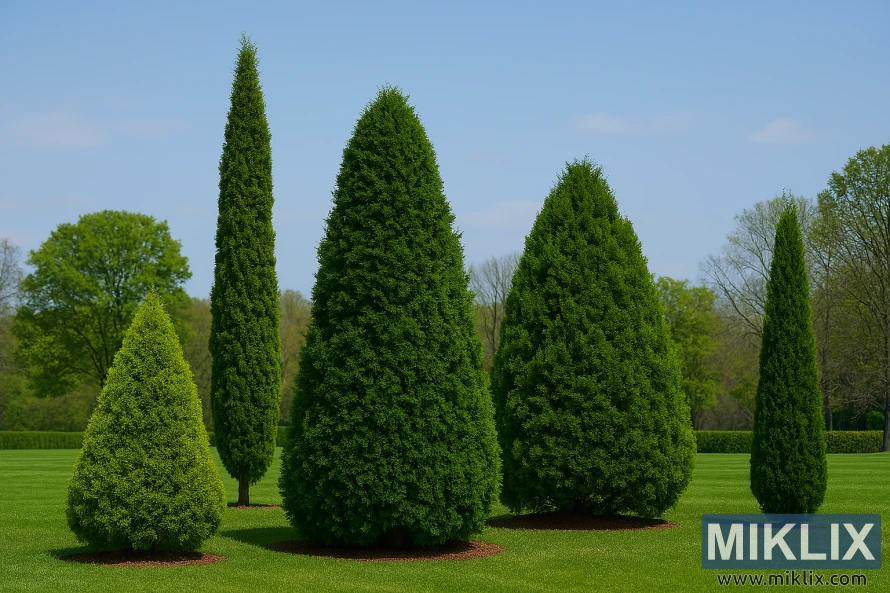
Planting and Care Guidelines
Proper planting and care are essential for the long-term health and beauty of your Arborvitae. Follow these guidelines to ensure your trees thrive for years to come:
Proper planting technique ensures healthy establishment and growth of Arborvitae
Planting Instructions
Site Selection
- Choose a location with at least 6 hours of sunlight daily (most varieties)
- Ensure good air circulation to prevent disease
- Avoid low-lying areas where water collects
- Consider mature size when placing near structures
Soil Preparation
- Arborvitae prefer well-drained, slightly acidic to neutral soil (pH 6.0-8.0)
- Amend heavy clay soils with compost to improve drainage
- Add organic matter to sandy soils to improve moisture retention
- Test soil pH and amend if necessary
Planting Steps
- Dig a hole 2-3 times wider than the root ball but no deeper than the height of the root ball
- Gently remove the tree from its container and loosen the outer roots
- Place the tree in the hole with the top of the root ball level with or slightly above the surrounding soil
- Backfill with the original soil, tamping gently to remove air pockets
- Create a shallow basin around the tree to hold water
- Water thoroughly after planting
- Apply 2-3 inches of mulch around the base, keeping it away from the trunk

Ongoing Care
Watering
- Water deeply once or twice weekly during the first growing season
- Once established, water during extended dry periods
- Use soaker hoses or drip irrigation for efficient watering
- Avoid overhead watering which can promote disease
Fertilizing
- Apply a balanced, slow-release fertilizer in early spring
- Use a fertilizer formulated for evergreens (higher in nitrogen)
- Avoid fertilizing after mid-summer to prevent tender new growth before winter
- Follow package directions for application rates
Pruning
- Most Arborvitae require minimal pruning
- Remove dead or damaged branches as needed
- Light shearing in early spring can maintain shape
- Never cut into bare wood as it may not regenerate
Winter Protection
- Wrap young trees with burlap in areas with heavy snow
- Apply anti-desiccant spray in late fall to prevent winter burn
- Avoid planting in areas with strong winter winds
- Continue watering until ground freezes

Common Arborvitae Problems
Watch for these common issues and address them promptly:
- Bagworms: Small, cone-shaped bags hanging from branches. Remove by hand or treat with Bacillus thuringiensis (Bt) in early summer.
- Winter Burn: Browning foliage in late winter/early spring. Prevent with adequate fall watering and anti-desiccant sprays.
- Deer Damage: Browsing can severely damage Arborvitae. Use repellents, physical barriers, or plant resistant varieties like 'Green Giant'.
- Spider Mites: Tiny pests that cause yellowing and stippling of foliage. Treat with insecticidal soap or horticultural oil.
Landscape Design Ideas with Arborvitae
Arborvitae's versatility makes it a valuable addition to virtually any landscape design. Here are some creative ways to incorporate these evergreen beauties into your garden:
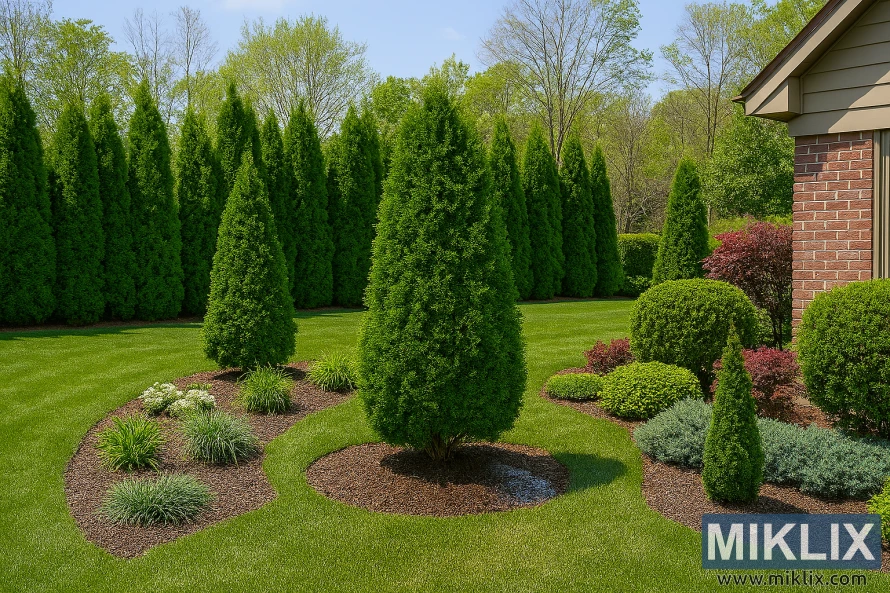
Privacy Screens
Plant taller varieties like 'Green Giant' or 'Techny' in a row to create a living fence. Space plants according to variety recommendations to create a solid screen within a few years. For immediate privacy, plant closer together and thin if necessary as they mature.
Foundation Plantings
Use medium-sized varieties like 'Emerald Green' or dwarf varieties like 'Globe' around your home's foundation. Their evergreen foliage provides year-round structure and frames your home beautifully without overwhelming the architecture.
Formal Gardens
Arborvitae's naturally symmetrical shape makes it perfect for formal garden designs. Use matched pairs to frame garden entrances or create a structured backdrop for flowering perennials. Their consistent form provides a sense of order in the landscape.
Mixed Borders
Incorporate Arborvitae into mixed borders for year-round structure. Their evergreen presence provides a backdrop for seasonal flowers and adds winter interest when deciduous plants are dormant. Combine with flowering shrubs and perennials for multi-season appeal.
Container Plantings
Dwarf varieties like 'Mr. Bowling Ball' or 'Fire Chief' work beautifully in containers for patios and entryways. Their slow growth and compact habit make them ideal for container culture, providing year-round greenery in small spaces.
Accent Plants
Use distinctive varieties like the golden 'Fire Chief' or the narrow 'North Pole' as focal points in the landscape. Their unique form or color draws the eye and creates visual interest, especially when placed strategically at the end of a sight line.
Dwarf globe Arborvitae varieties create structure and year-round interest in formal garden designs
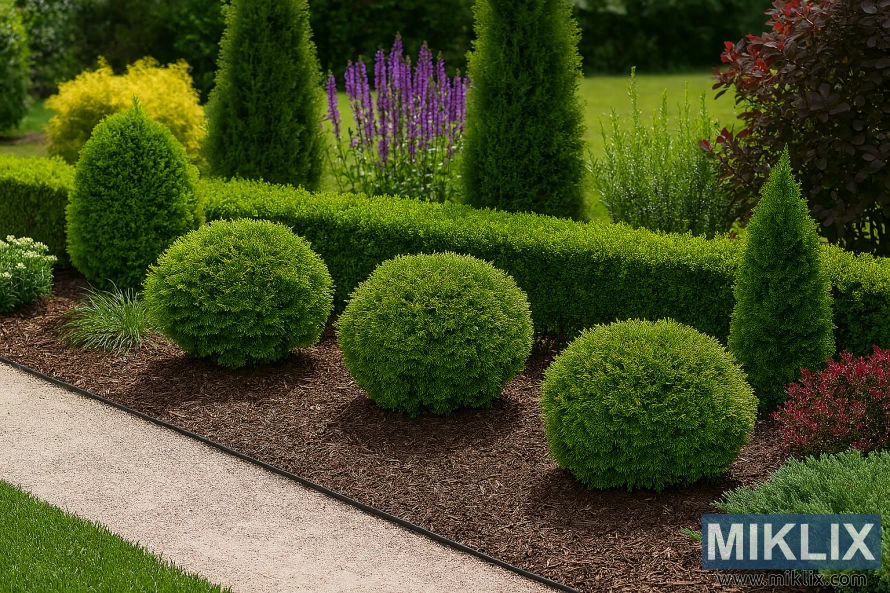
Companion Plants for Arborvitae
Enhance your Arborvitae plantings with these complementary companion plants:
Flowering Shrubs
- Hydrangeas
- Rhododendrons and Azaleas
- Viburnums
- Weigela
Perennials
- Hostas
- Astilbes
- Daylilies
- Ornamental Grasses
Finding Your Perfect Arborvitae
A thoughtfully designed landscape incorporating various Arborvitae varieties creates year-round beauty and function
Selecting the best Arborvitae variety for your garden depends on your specific needs, space constraints, and climate conditions. Consider these final recommendations based on common landscape requirements:
For Privacy Screens
- Green Giant: Fastest growing, tallest option
- Emerald Green: Medium height, narrow spread
- Techny: Excellent cold hardiness, dense foliage
For Small Spaces
- North Pole: Narrow columnar form
- Globe: Compact, rounded shape
- Fire Chief: Colorful accent, limited size
For Cold Climates
- Techny: Superior winter hardiness
- North Pole: Resistant to winter burn
- American: Native adaptability
Whichever variety you choose, proper planting and care will ensure your Arborvitae thrive for decades, providing beauty, privacy, and structure in your landscape. These versatile evergreens offer solutions for virtually any garden challenge while requiring minimal maintenance once established.
Remember that Arborvitae are long-lived trees that will continue to grow and mature over many years. Taking the time to select the right variety for your specific needs and providing proper care during establishment will reward you with decades of landscape beauty and functionality.

Further Reading
If you enjoyed this post, you may also like these suggestions:
- The Best Ginkgo Tree Varieties for Garden Planting
- The Best Maple Trees to Plant in Your Garden: A Guide to Species Selection
- Best Beech Trees for Gardens: Finding Your Perfect Specimen
